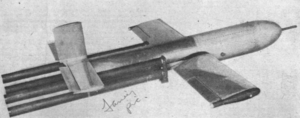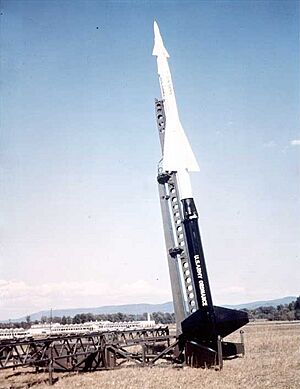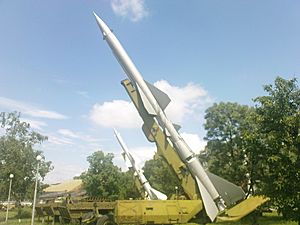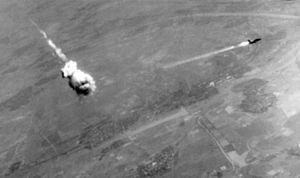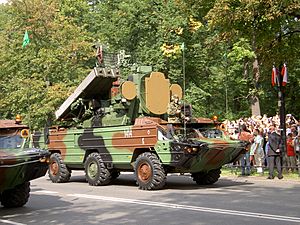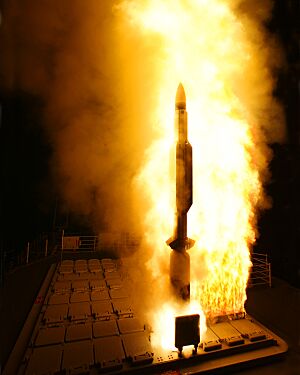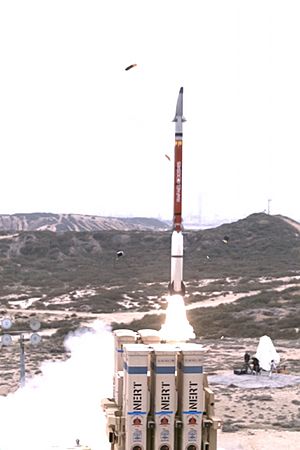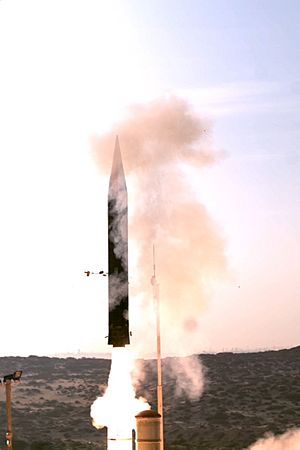Surface-to-air missile facts for kids
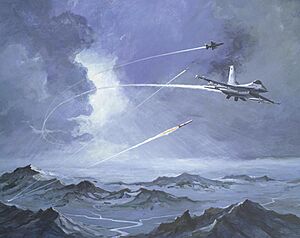
A surface-to-air missile (often called a SAM) is a special type of missile. It's launched from the ground or a ship to hit and destroy things in the air, like aircraft, other missiles, or even targets on the ground. SAMs are a key part of anti-aircraft systems. Today, these missiles have mostly replaced older anti-aircraft guns for stopping air threats.
The idea for SAMs first came up during World War II, but no working systems were ready for use then. In the 1940s and 1950s, new SAM systems were developed and started being used by major armies. Over time, these missiles became smaller and easier to move. Some modern ones are even small enough for one person to carry! Missiles used on ships also changed, starting with long-range weapons and then getting smaller to create layers of defense. This progress meant that gun-based systems were only used for very close-up defense.
The American Nike Ajax was the first SAM system that could be guided. The Soviet Union's S-75 Dvina was the most produced SAM. Today, some well-known SAMs include the Patriot and S-300 for wide areas, naval missiles like the SM-6 and MBDA Aster, and small, portable ones like the Stinger and Strela-3.
Contents
History of SAMs
The first known idea for a guided surface-to-air missile appeared in 1925. It suggested a rocket that would follow a light beam to its target. In 1931, an inventor named Gustav Rasmus drew a design for a missile that would find its target by listening for the sound of an aircraft's engines.
SAMs in World War II
During World War II, people realized that regular anti-aircraft guns (called "flak") were not very good at stopping fast, high-flying bombers. Flak shells had a small explosion area, so it was hard to hit a plane. To destroy one bomber, thousands of shells often had to be fired.
As planes flew higher and faster, even bigger guns were needed, which cost more and fired slower. By 1942, experts knew that flak would soon be useless against new, faster planes like jets. This made the idea of guided missiles much more important.
German Missile Efforts
Serious talks about developing SAMs began in Germany in 1941. A "flak rocket" was suggested, and scientists like Wernher von Braun were asked to study guided missiles that could reach very high altitudes.
By 1943, when Allied air forces started large bombing raids, Germany began serious work on several rocket designs. These included the Wasserfall, Henschel Hs 117 Schmetterling, Enzian, and Rheintochter. There was also the unguided Taifun rocket, meant to be fired in large groups.
These designs generally fell into two groups:
- Some missiles would fly up in front of bombers and then turn to fly towards them at slower speeds.
- Others were very fast, often supersonic, and flew directly at their targets from below.
Both types used radio control to guide them. The war ended before any of these missiles were ready for combat.
Allied Missile Efforts
The British had unguided anti-aircraft rockets early in World War II. But because the Allies usually controlled the skies, there wasn't a huge need for guided missiles at first.
However, in 1943, Allied ships were attacked by German Henschel Hs 293 and Fritz X glide bombs. These bombs were launched from far away, out of reach of ship guns, and were too small and fast to hit easily.
To fight this new threat, the U.S. Navy started Operation Bumblebee to create a powerful missile. This project eventually led to the RIM-8 Talos missile, which became operational 16 years later.
Later in the war, many ships were lost to kamikaze attacks. This pushed the British to develop the Fairey Stooge and Brakemine, and the U.S. Navy to work on the SAM-N-2 Lark. The war ended before these projects were fully ready for combat.
After World War II
After the war, many countries worked on SAMs. Several systems started being used in the early to mid-1950s.
The U.S. Army began its Project Nike in 1944. The Nike Ajax was tested in 1952 and became the first working SAM system in March 1954. A stronger version, the Nike Hercules, came out in 1958. It was the first SAM that could carry a nuclear warhead.
The Soviet Union also started developing SAMs during the Cold War. Joseph Stalin wanted a missile system to protect Moscow from air raids. This led to the S-25 Berkut system, which became active in 1955. It was a fixed system, but the Soviets also developed a more mobile one, the famous S-75 Dvina (also known as SA-2), which was very powerful and used for many years. The Soviet Union, and later Russia, stayed leaders in SAM development.
The British also continued their SAM work. Two main designs, the Bristol Bloodhound and the English Electric Thunderbird, became active in the late 1950s. A naval missile, the Sea Slug, followed in 1961.
SAMs in the Vietnam War
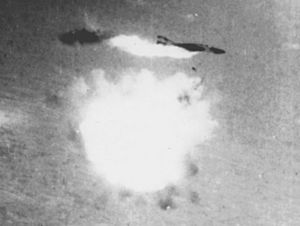
The Vietnam War was the first major conflict where guided anti-aircraft missiles seriously challenged modern supersonic jet aircraft. It was a direct battle between the latest Soviet air defense technology and advanced US jets.
The USAF learned to fight back. At first, attacking missile sites was hard. But with special "Wild Weasel" planes carrying Shrike and Standard ARM missiles, the situation changed. Both sides kept developing new tactics. By 1972, during Operation Linebacker II, the US had learned a lot about the S-75 system. They used this knowledge to show that their strategic bombers could fly in areas full of SAMs.
During the war, the Soviet Union sent over 7,600 SAMs to North Vietnam. North Vietnam launched about 5,800 of them. North Vietnam said that 31% of US aircraft losses were due to S-75 missiles. The S-75 system greatly helped North Vietnamese anti-aircraft guns by sharing radar information. However, the US stated that only 205 of their aircraft were lost to SAMs.
Smaller and Faster Missiles
Early SAM systems were large, hard to move, and took a long time to set up. But they became very effective. By the early 1960s, flying high and fast in combat was very dangerous because of SAMs. To avoid them, planes had to fly lower, below the missile radar's view. This led to new types of aircraft, like the F-111.
So, SAMs quickly changed in the 1960s. Since targets were flying lower, battles would be at shorter distances and happen fast. Shorter distances meant missiles could be much smaller, making them easier to move. By the mid-1960s, most modern armies had short-range missiles mounted on trucks or light armored vehicles. These could move with the troops they protected. Examples include the 2K12 Kub (SA-6), 9K33 Osa (SA-8), MIM-23 Hawk, Rapier, Roland, and Crotale.
Later, in the 1960s and 1970s, new missiles that flew very low over the sea (called sea-skimming missiles) appeared. This led to more mid- and short-range SAMs to defend against them. The UK's Sea Cat was an early example for ships. The American RIM-7 Sea Sparrow also became very popular on naval ships.
MANPADS: Missiles a Person Can Carry
As aircraft flew lower and missiles got better, it became possible to build effective anti-aircraft missiles that one person could carry. These are called MANPADS (Man-Portable Air-Defense Systems). The first examples were used in World War II, but they weren't very effective against fast jets.
By the 1960s, technology had improved enough. This led to the FIM-43 Redeye, SA-7 Grail, and Blowpipe. In the 1980s, even better designs came out, like the FIM-92 Stinger, 9K34 Strela-3 (SA-14), and Starstreak. These had much better performance. Later, in the 1990s and 2000s, China developed its own designs, such as the FN-6.
Even as SAMs improved, anti-aircraft guns also got better. But missiles pushed guns into roles where they were only used for very short-range defense. By the 1980s, guns were mostly used to protect airfields and ships, especially against cruise missiles. By the 1990s, even these jobs were being taken over by new MANPADS and similar short-range weapons like the RIM-116 Rolling Airframe Missile.
How SAMs Work
Surface-to-air missiles are usually grouped by how they are guided, how easily they can move, and their altitude and range.
Movement and Range
Missiles that can fly longer distances are usually heavier, making them harder to move. This creates three main types of SAM systems:
- Heavy, long-range systems: These are fixed in one place or can move only a little.
- Medium-range systems: These are mounted on vehicles and can often fire while moving.
- Short-range MANPADS: These are light enough for one person to carry.
Modern long-range missiles like the MIM-104 Patriot and S-300 (missile) can hit targets up to about 150 kilometers (93 miles) away. They are also quite mobile and quick to set up. This is a big improvement over older systems like the MIM-14 Nike Hercules or S-75 Dvina, which needed large, fixed sites. This improvement is thanks to better rocket fuels and smaller electronics in their guidance systems. Some very long-range systems, like the Russian S-400, can reach targets 400 kilometers (250 miles) away.
Medium-range missiles, such as the Rapier and 2K12 Kub, are made to be very mobile and set up quickly. Many are on armored vehicles so they can move with an army.
Missiles have also improved in how well they can turn and change direction in the air. Israel's David's Sling Stunner missile, for example, is designed to intercept new types of ballistic missiles. It has a special engine that gives it extra speed and agility during the final part of its flight.
MANPADS first appeared in the 1960s. They usually have a range of about 3 kilometers (1.9 miles). They are good at hitting attack helicopters and planes making ground attacks. Against fixed-wing aircraft, they can force planes to fly outside their range, making it harder for them to attack targets on the ground. MANPADS are sometimes put on vehicles, like the Avenger system, to make them even more mobile.
Ship-based anti-aircraft missiles are also SAMs. They are very important for all modern warships to defend against air threats, especially against missiles that skim low over the sea. Many warships carry different types of SAMs (long, medium, and short-range) to create a strong, layered air defense.
Guidance Systems
SAM systems generally use two main ways to guide themselves: radar or other methods.
Longer-range missiles usually use radar to find and guide them. Early SAMs used tracking radars on the ground to send guidance information to the missile using radio control. This is called command guidance. In the 1960s, semi-active radar homing (SARH) became more common. With SARH, the missile itself listens for the radar signals bouncing off the target and flies towards them. This means most of the equipment stays on the ground, and the ground station doesn't need to talk to the missile after it's launched.
Smaller missiles, especially MANPADS, often use infrared homing systems. These are "fire-and-forget" missiles. Once launched, they find and track the target on their own by sensing its heat, without needing any signals from the ground. SARH systems, on the other hand, need the ground radar to keep "lighting up" the target, which might expose the radar.
Some newer short-range systems use a type of SARH but with laser light instead of radar. These are small, fast, and very accurate. A few older designs use only optical tracking and command guidance, like the British Rapier system, which was very accurate.
Almost all SAM systems, big or small, include IFF systems. These help tell if a target is a friendly aircraft or an enemy before the missile is fired. While IFF is less critical for MANPADS (because the target is usually seen clearly), most modern MANPADS still have it.
Finding Targets
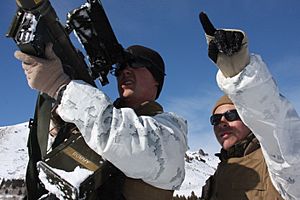
Long-range SAM systems usually use radar to find targets. Depending on how old the system is, it might then pass the target information to a separate tracking radar for the attack. Shorter-range systems are more likely to rely on seeing the target visually.
Sometimes, systems combine different ways to find targets. For example, the MIM-72 Chaparral missile was fired by sight, but it also worked with a small radar that showed targets to the operator. This radar would send information to the Chaparral using a data link. Similarly, the UK's Rapier system had a simple radar that showed the general direction of a target with lights. The missile operator would then look in that direction with a telescope to find the target visually.
See also
 In Spanish: Misil superficie-aire para niños
In Spanish: Misil superficie-aire para niños
- List of surface-to-air missiles
- Anti-aircraft warfare
- Man-portable air-defense systems
- Missile guidance
- List of anti-aircraft weapons
- List of NATO reporting names for surface-to-air missiles
- Suppression of Enemy Air Defenses (SEAD), the mission of finding and destroying SAM and AA gun installations. The SEAD mission in the United States Air Force is designated "Wild Weasel".



